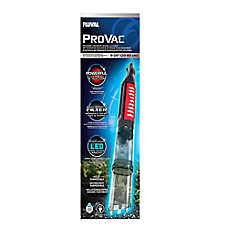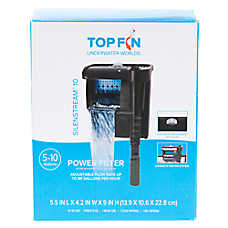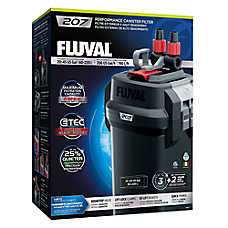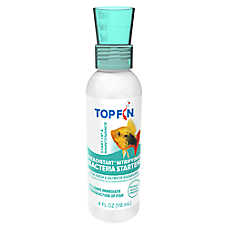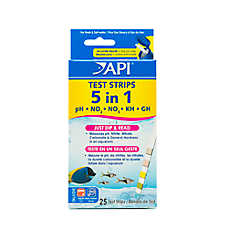Aquarium Water Quality Care Guide
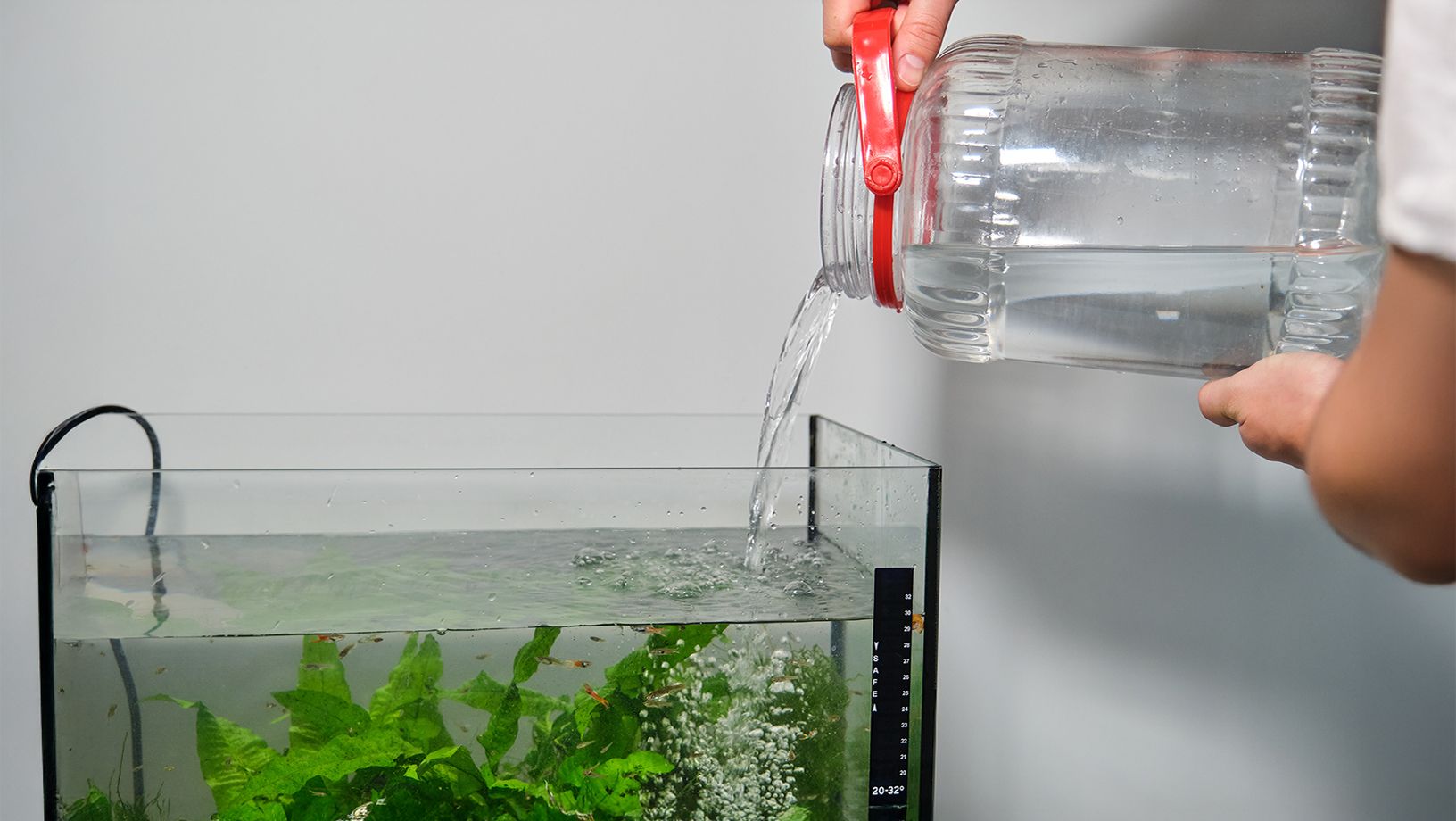
In this Article
Keeping Your Aquarium Healthy
Every fish keeper wants a healthy, happy aquarium. The most important factor in achieving this dream is maintaining good water quality. Water quality refers to maintaining the temperature, pH, alkalinity, ammonia, nitrite, nitrate, and other parameters in your system.
Fishkeeping involves a surprising amount of chemistry! You’ll can monitor these values using test strips or liquid kits. Test strips are fast and convenient while liquid test kits are typically more accurate. Let’s dig into these values and how they interact with each other and your fish!
What is Water Quality?

Ideally, aim to check your system’s water quality every 1-2 weeks. Keeping a record of these results helps you answer when and sometimes why things change in your system. Periodically checking your tap water is another important monitoring step.
Pay particular attention to the three parts of the Nitrogen Cycle (see below). Ammonia, Nitrite, and Nitrate are the result of the waste fish generate as they go about their lives. Monitoring and maintaining levels within preferred ranges will ensure a safe environment. Test results that drift above or below preferred ranges may cause stress and weaken a pet’s immune system putting them at risk for illness or even death.
- Ammonia is highly toxic to fish. Ammonia is constantly being produced, primarily from fish waste and decomposing organic matter (uneaten food or dead plants), which are broken down by bacteria in a healthy aquarium. New aquariums are more prone to high ammonia, but an existing system can be overwhelmed with too much decaying organic material or after treating the system for illness. Changes in temperature and oxygen can also alter ammonia levels.
- Levels should be maintained at 0 ppm (mg/L).
- Nitrite is also highly toxic to fish. Nitrite is the second step in the Nitrogen Cycle and is produced from oxidation of ammonia by beneficial bacteria, and from uneaten food.
- Levels should be maintained at 0 ppm (mg/L).
- Nitrate is the third step in the Nitrogen Cycle and is the result of oxidation of nitrite from beneficial bacteria. Nitrate is the least toxic form of nitrogenous waste, but can still harm fish in high concentrations.
- Levels should be below 20 ppm (mg/L).
- Chlorine or chloramines are added to tap water to make it safe to drink but are toxic to fish. A water conditioner or dechlorinator must be used to remove chlorine or chloramine from tap water before it is added to your aquarium. Check your municipal water supplier to see if they add chloramines since chloramines need a different water conditioner than just chlorine.
- Levels should be maintained at 0 ppm (mg/L).
- Total hardness or general hardness, GH, is the measure of calcium and magnesium ions in water. Depending on species and the kind of aquarium you want to establish, most aquatic pets can live in a wide range of GH.
- Total alkalinity or carbonate hardness, KH, is the measure of carbonates and bicarbonates in water. Appropriate KH levels help stabilize pH levels in the aquarium and are necessary for the conversion of ammonia into nitrite. Most aquatic pets can live in a wide range of KH, however in areas with low KH water, you will need to artificially raise alkalinity, depending on your fish.
- Levels typically maintained between 50-200 ppm (mg/L).
- pH or potential of Hydrogen represents a form of hydrogen ion concentration in the water. This is where we get the phrases acidic or basic. Neutral pH is 7.0 but most tropical fish, and the beneficial bacteria they rely on, tolerate a range of 6.5-8.3. However, each fish species has a preferred range. Research your fish to determine their specific needs. pH also plays a role in the toxicity of ammonia and maintaining a stable pH is important to reducing stress in your fish
- Levels typically maintained between 6.5-8.3 but is species dependent.
- Optimal temperature ranges vary with aquatic animal species. Temperature may also affect other water quality levels (ammonia and oxygen), parasite life cycles, disease progression, animal metabolism, and decay of organic matter.
- Cold water fish such as goldfish and koi typically prefer 65-70°F water
- Tropical fish such as bettas, angelfish, neons, guppies and platies prefer water from 74-78°F
Water Parameter | Target Range |
Ammonia | 0ppm (mg/L) |
Nitrite | 0ppm (mg/L) |
Nitrate | Less than 20ppm |
pH | 6.5-8.3 |
Chlorine | 0ppm (mg/L) |
Alkalinity | 50-200ppm |
The Nitrogen Cycle
Healthy aquariums rely on the Nitrogen Cycle, the process that allows beneficial bacteria to consume and detoxify waste products into less harmful forms that can be removed with regular maintenance and water changes. The beneficial bacteria grow on every surface in the aquarium, including the gravel, decorations and filter media. These helpful bacteria break down unhealthy fish byproducts (ammonia and nitrite) and convert them into nitrate through a process called nitrification.
Nitrate levels are maintained with routine water changes. Live plants will also help reduce nitrate levels by using ammonia to grow and flourish within your aquarium. Unfortunately, while products exist to help reduce nitrate, the only effective ways to remove nitrate are water changes and plants. Some very heavily planted tanks that are lightly stocked with fish can be maintained without water changes, but these tanks are typically kept by experienced hobbyists.
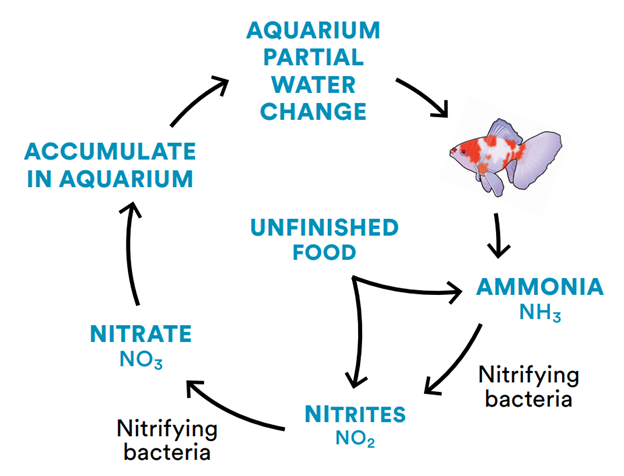
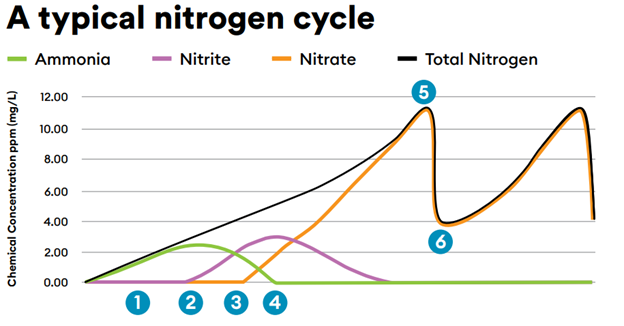
How the nitrogen cycle works
- Set up your aquarium with the appropriate filtration and add beneficial bacteria to the aquarium.
- Choose a cycling method, fish-in cycle (uses fish and their waste to add ammonia to the water) or a fishless cycle (uses ammonium chloride).
- There are two options for cycling: fish in or fishless.
- Fishless cycling: This is a newer approach to starting an aquarium that doesn’t stress your new fish with elevated Ammonia and Nitrite levels. With Fishless Cycling, you will set up your system and add a small amount of fish food or an ammonium chloride solution. With Fishless Cycling, continue to add fish food or ammonium chloride to maintain Ammonia between 1.5ppm and 5ppm. NEVER ADD AMMONIUM CHLORIDE TO AN AQUARIUM WITH FISH.
- Fish-in cycling: This is the oldest way of cycling a system. This method is very stressful for these early fish and can be fatal if they are not monitored closely. Fish-In Cycling involves setting up your tank and adding only a few fish. Add 2-3 of the fish you want to keep to your new tank. Feed the fish lightly, only what they eat in 1-2 minutes, and perform water changes when ammonia is greater than 1.0ppm.
- Regardless of which method you choose, since no beneficial bacteria have colonized yet, levels of ammonia will start to go up (see #1 on graph). To colonize beneficial bacteria that will convert ammonia into nitrite, it is necessary to have elevated levels of ammonia for a short period of time.
- If you have fish in the tank, perform water changes when the Ammonia reads above 1ppm.
- If you do not have fish in the tanks, Ammonia levels can rise without intervention and should be maintained between 1.5-5ppm until Nitrite begins to rise (see #2).
- Do not use ammonia detoxifying chemicals during this time as those chemicals prevent the bacteria from being able to use that ammonia and slow down the cycling process. Water changes will maintain the ammonia in a safe range without binding the ammonia.
- As the ammonia levels rise (see #2), the first type of beneficial bacteria will begin to colonize on the gravel, ornaments, and in the filter. Then, the ammonia levels will drop and the nitrite levels will rise (see #3). To colonize bacteria that will convert nitrite into nitrate, it is necessary to have elevated levels of nitrite for a short period of time.
- If you have fish in the tank, perform water changes when the Nitrite reads above 1.0ppm. If you do not have fish in the tanks, Nitrite levels can rise without intervention.
- Do not use nitrite detoxifying chemicals during this time as those chemicals prevent the bacteria from being able to use that nitrite and slow down the cycling process. Water changes will maintain the nitrite in a safe range without binding the nitrite.
- As the nitrite levels rise, the second type of beneficial bacteria will begin to colonize on the gravel, ornaments, and in the filter. Then, the nitrite levels will drop, and the nitrate levels will rise (see #4).
- Eventually the ammonia and nitrite levels will drop to 0 ppm (mg/L) and the nitrate levels will rise (see #5). The whole cycle takes approximately 3-7 weeks but varies depending on aquarium size, beneficial bacteria use and type, and type of fish or ammonium chloride.
- Nitrate is the end product of the cycle, which must be removed with regular partial water changes (see #6) to keep the level at or below 20 ppm (mg/L).
- Pro tip: Always make sure the water being added during a change is dechlorinated and within three degrees above or below the temperature of the water in the tank. If doing a fishless cycle, it is now safe to introduce fish 2-3 at a time.
Tips For A Successful Nitrogen Cycle
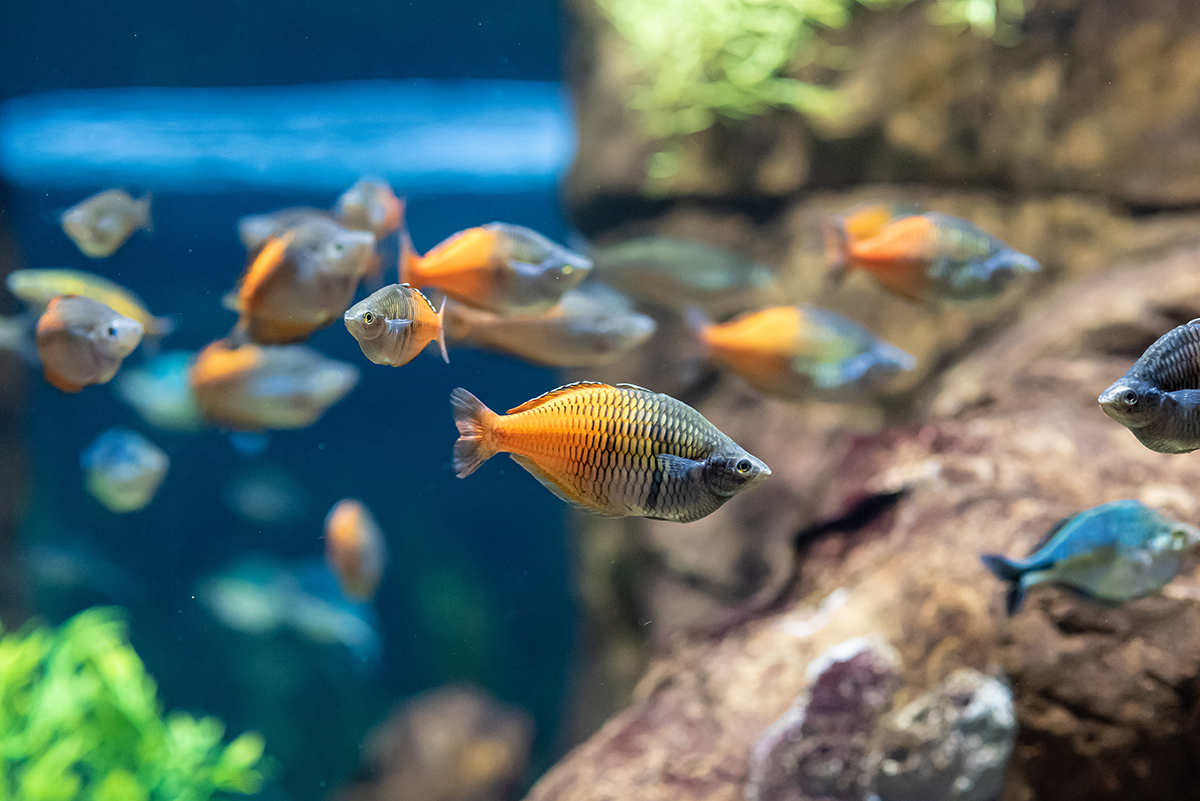
The process can be stressful and dangerous to aquatic pets so testing the water frequently and monitoring the nitrogen parameters is vitally important. Be prepared to do a water change any time the ammonia or nitrite reach dangerous levels.
If cycling your aquarium with fish:
- Add only a few fish to reduce the amount of waste produced and be prepared to change the water if their behavior changes or your test results are out of range.
- Choose fish you want to keep long term.
- Feed lightly during the cycling process. More food means more waste, which means higher amounts of ammonia and higher nitrite levels.
- After the aquarium is cycled, do not add more than 2-3 new fish at a time. Each fish produces waste, and it takes time for the bacteria to build up enough to process that waste.
- Additional fish should never be added while ammonia or nitrite are above 0ppm.
- Beneficial Bacterial solutions can help kickstart a cycle in your new tank. If you have an existing aquarium, taking some of the filter media from your existing tank and adding it to your new tank can also speed up the process.
If cycling your aquarium without fish:
- Only use ammonium chloride designed for aquariums.
- Follow the manufacturer’s instructions to achieve the cycle as described previously. During the cycling process (timing varies but may take 3-7 weeks), test water at least once a week with a water testing kit.
When should I test my water quality?
- 2-3 times a week during cycling
- Fish are sluggish, near the bottom of the tank
- Fish are at the top, breaking the water to breathe
- Fish are not eating
- Sudden behavior changes in your fish
- Water is cloudy
- Water smells funny
PetSmart offers free water quality testing and one of our knowledgeable associates can help you get your system balanced.
When should I contact a veterinarian?
- Contact an aquatic veterinarian if you notice the following signs:
- Unusual swimming pattern
- Thinness or decreased appetite
- Abdominal swelling
- Inflamed or discolored skin/fins
- Fins clamped to sides of body
- Scraping body on rocks (flashing)
- Visible signs of illness or recent fish loss
If your fish show any of the signs above, we recommend using the “Find a Fish Vet” tool at fishvets.org or wavma.org to locate a qualified aquatic veterinarian in your area.
Shopping Checklist
- Water testing kit or strips
- Water conditioner/dechlorinator
- Beneficial bacteria starter
- Depending on your tap water and the type of fish species, you may also need:
- pH buffer
- Alkalinity booster
Ready to learn more?
This guide is a great starting place, but we encourage you to do more research on the individual species that you are keeping so that you can be as successful as possible with your aquarium!
Vet Assured™: Pets purchased at PetSmart are part of our exclusive Vet Assured™ program, designed by PetSmart veterinarians to help improve the health and well-being of our pets. Our vendors meet a high standard in caring for pets and screening them for common illnesses. This program also includes specific standards for in-store pet care.
The PetSmart Promise: If your pet becomes ill during the initial 14-day period, or if you’re not satisfied for any reason, PetSmart will gladly replace the pet or refund the purchase price.
Safety tips for you and your pet:
1. ALL ANIMALS can potentially carry viral, bacterial, fungal, and parasitic diseases contagious to humans. 2. Thoroughly wash your hands with warm, soapy water before and after contact with any pet or its habitat. 3. Adults should assist children with hand washing after contact with a pet, its habitat or aquarium water. 4. Always add a dechlorinator or water conditioner and bacteria starter to tap water before adding it to the aquarium. 5. Do not use soaps or detergents to clean aquarium or decor, since they are toxic to fish. For more information, visit petsmart.com, cdc.gov/healthypets, or contact your veterinarian.
This care guide contains general information for the proper care of your pet, but is not comprehensive and is not a substitute for veterinary advice or care. PETSMART and VET ASSURED are trademarks of PetSmart Home Office, Inc. © 2025 PetSmart. All rights reserved.
The PetSmart Promise: If your pet becomes ill during the initial 14-day period, or if you’re not satisfied for any reason, PetSmart will gladly replace the pet or refund the purchase price.
Safety tips for you and your pet:
1. ALL ANIMALS can potentially carry viral, bacterial, fungal, and parasitic diseases contagious to humans. 2. Thoroughly wash your hands with warm, soapy water before and after contact with any pet or its habitat. 3. Adults should assist children with hand washing after contact with a pet, its habitat or aquarium water. 4. Always add a dechlorinator or water conditioner and bacteria starter to tap water before adding it to the aquarium. 5. Do not use soaps or detergents to clean aquarium or decor, since they are toxic to fish. For more information, visit petsmart.com, cdc.gov/healthypets, or contact your veterinarian.
This care guide contains general information for the proper care of your pet, but is not comprehensive and is not a substitute for veterinary advice or care. PETSMART and VET ASSURED are trademarks of PetSmart Home Office, Inc. © 2025 PetSmart. All rights reserved.

